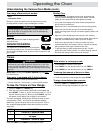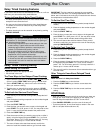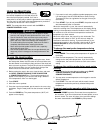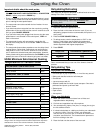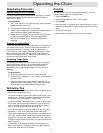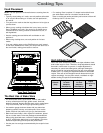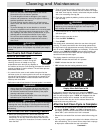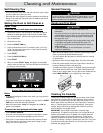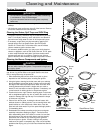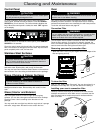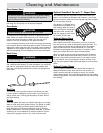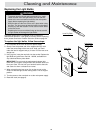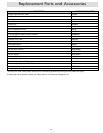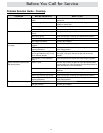
24
25
General Cleaning
CAUTION
Use only a sponge, soft cloth, fibrous or plastic brush, or nylon
pad for cleaning the surfaces of your range. Avoid the use of
abrasive cleaners such as steel wool.
Knobs and Trim Rings
CAUTION
Do not soak the knobs in water or put them in the
dishwasher.
Do not remove the trim rings from the range. Clean only the
outside edges of the trim rings. If you get moisture inside
the trim rings, damage to the knob lights or other parts of
the range can occur.
Installing the range knobs in the wrong position may result
in damage to the griddle included with the range. The
knobs for the right burners are marked with the maximum
griddle settings.
To prevent damage, do not use abrasive or corrosive
cleaners or applicators.
•
•
•
•
Wash the knobs regularly with a solution of warm soapy water.
Dacor
recommends hand dishwashing liquid.
Turn the knobs to the off position to remove them for cleaning
or replacement.
Grasp each knob and pull straight back, off of the valve shaft.
Clean the outside edges of the trim rings while the knobs are
removed. Wipe them with a soft damp rag.
To replace the knobs, align the “D-shaped” opening on the back
of the knob with the end of the valve shaft. Carefully push the
knob on until it stops. Make sure you put the two knobs with the
words “MAX GRIDDLE” on the right burner valve stems.
Cleaning the Cooktop
To keep the cooktop looking and operating its best, clean it after
every use. Also, quickly wipe up spills that occur while cooking.
Be careful not to touch any hot areas. Spills that remain on hot
burner parts will be very difficult to clean, especially if allowed to
burn on. Certain types of food, such as tomatoes, citrus juices,
vinegar, alcohol and milk can damage the finishes if you allow
them to stand for any length of time.
IMPORTANT: The cooktop is exposed to extremely high
temperatures. The grates are put under a lot of stress when hot
utensils are placed on them. In addition, the cooktop parts are
occasionally exposed to acidy food spill-overs. These severe
operating conditions, cause the porcelain enamel parts on your
cooktop to undergo a change in appearance over time. If you care
for and clean these parts carefully, you will slow down, but not
eliminate, the aging process.
•
•
•
•
•
Cleaning and Maintenance
Self-Cleaning Tips
If any soil remains in the oven after the self-clean cycle is done,
you may repeat the cycle if you want.
Self-clean the oven regularly to prevent excessive soil build-up.
Doing so will make the self-clean cycle work better and reduce
smoke and odors.
Setting the Oven to Self-Clean at a
Later Time
To set the oven to self-clean at a later time:
Prepare the oven for self-cleaning as instructed on page 23.
Observe all safety precautions and remove all items listed
from inside the oven. Clean the door gasket and around the
door as instructed.
Close the oven door.
Press the START TIME key.
Enter the desired start time. For example, press 1-2-3-0 for
12:30. You may enter a time up to 11 hours and 59 minutes
ahead of the present time.
Press START.
Press the SELF-CLEAN key.
Press START.
When you press START, “Delay” will appear on the display
and the oven door will lock. The oven will start to self-clean at
the time you have selected.
Notes:
If you want the display to return to the clock, you may push the
CLOCK key.
If the clock is showing on the display, you may push the START
TIME key to check the self-clean start time.
When self-clean starts, “Delay” will disappear and “ON” will
appear on the display.
To cancel the time delayed self-clean cycle:
Press CANCEL/SECURE.
If the self-clean process has not started, allow about a minute
for the door to unlock before attempting to use the oven.
If the oven is in the middle of the self-clean process, the door
will unlock when the oven has cooled down enough to open
safely. The oven will still be hot.
•
•
1.
2.
3.
4.
5.
6.
7.
8.
•
•
•
•
•
•
Display When Self-Clean Delay is ON




